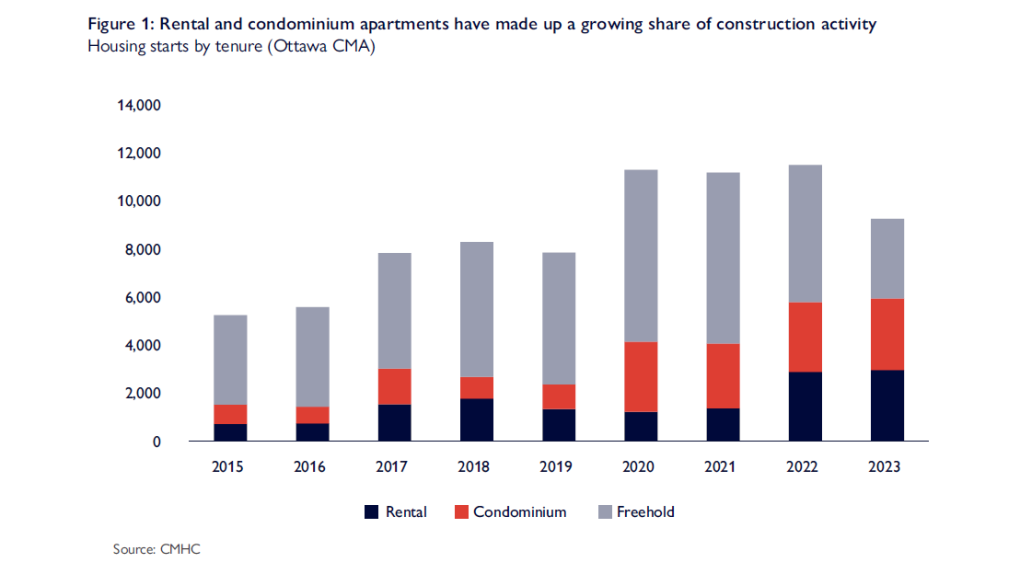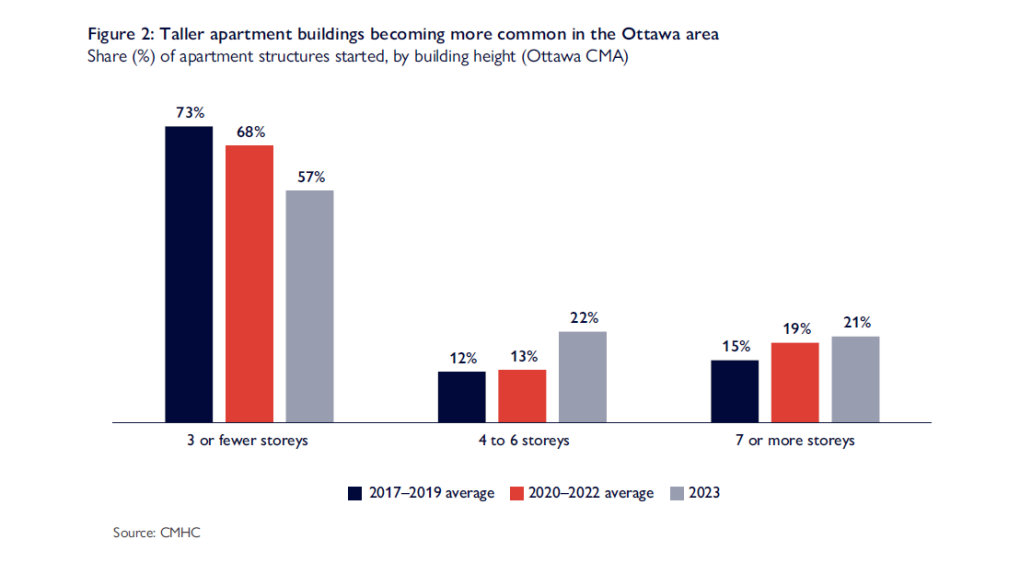Ottawa becoming a rental city, CMHC report suggests
 Construction workers are seen at the site of an affordable housing project in the Thornecliffe Park region of Ottawa, on Thursday, Sept. 28, 2023. (Spencer Colby/THE CANADIAN PRESS)
Construction workers are seen at the site of an affordable housing project in the Thornecliffe Park region of Ottawa, on Thursday, Sept. 28, 2023. (Spencer Colby/THE CANADIAN PRESS)
Rental housing dominated construction in Ottawa last year, according to a new report from the Canada Mortgage and Housing Corporation (CMHC).
Residential construction declined significantly in 2023, with housing starts dropping to 9,245 units, a 19.5 per cent decline from the record high observed in 2022. But while single-detached and row housing starts fell compared to 2022, new construction for rental units and condominiums rose.
"There's been a shift toward rental construction over the past two years. Rental housing starts made up nearly one third of total starts in 2023, close to double the average of the previous five years," the report stated.
Apartment starts reached their highest level since the 1970s.
"The trend toward rental and condominium apartment construction follows increased demand in these market segments due to population growth, households looking for affordable options, and some seniors downsizing to smaller units," the CMHC said.
Demand from international migration and students, the high cost of home ownership, and people moving to Ottawa from other parts of Ontario were the main drivers for rental housing starts in 2023. The CMHC says rental and condominium apartment starts made up 63 per cent of total starts in 2023, compared to the average of 37 per cent for the period 2018-2022.
There was a modest increase in rental housing starts in 2023 over the record-high seen the year prior and a jump in new condominiums. The report shows 5,846 new apartments were built in Ottawa last year, up 2.1 per cent compared to 2022.
 Housing starts in Ottawa by year. (CMHC)
Housing starts in Ottawa by year. (CMHC)
Big demand for condos
The CMHC said condo starts reached a new high in 2023, increasing 3 per cent from 2022 numbers.
"As of the end of 2023, there were only 13 completed and unsold condominium units, highlighting continued demand for new units," the CMHC said.
Condominum starts increased in areas such as Chinatown, Hintonburg, Vanier and Alta Vista, as well as some suburban areas like Kanata, Stittsville, and western Orléans. Condo apartment construction declined in denser parts of the city like downtown, Lowertown and Centretown, the report says.
Taller buildings are also becoming more common, as the cranes dotting the skyline can attest. The CMHC notes that buildings with more than 20 storeys accounted for nearly 10 per cent of apartment structure starts in 2022 and 2023, compared to an average of 2 per cent over the 2017-2021 period. The number of units per building also rose 7 per cent compared to 2022.
 Apartment building heights in Ottawa by year. (CMHC)
Apartment building heights in Ottawa by year. (CMHC)
Single-detached home construction down significantly
The number of new single-detached homes built in Ottawa last year was the lowest level seen in the city since the mid 1990s, CMHC said.
"The Ottawa area experienced a slowdown in residential construction in 2023, driven by a significant decline in single-detached and row housing starts," the CMHC said.
Single-detached housing starts were down 45 per cent compared to 2022. Row house starts dropped by 38 per cent compared to 2022, marking a third year of declines in a row.
"Demand for single-detached and row houses also declined in 2023. Higher mortgage rates and home prices have led to a shift in demand toward more affordable rental and condominium units," the report said.
There were 1,535 single-detached housing starts in Ottawa last year, 208 new semi-detached homes and 1,678 new row houses.
The majority of single-detached and row housing starts were built in suburban communities such as Barrhaven, Stittsville, Kanata, Orléans and rural parts of the city.
"Increased construction costs resulting from higher financing rates and inflation that occurred in 2022 and 2023 contributed to the decline in construction in the region," the CMHC said.
CTVNews.ca Top Stories

Trump threatens to try to take back the Panama Canal. Panama's president balks at the suggestion
Donald Trump suggested Sunday that his new administration could try to regain control of the Panama Canal that the United States “foolishly” ceded to its Central American ally, contending that shippers are charged “ridiculous” fees to pass through the vital transportation channel linking the Atlantic and Pacific Oceans.
Wrongfully convicted N.B. man has mixed feelings since exoneration
Robert Mailman, 76, was exonerated on Jan. 4 of a 1983 murder for which he and his friend Walter Gillespie served lengthy prison terms.
opinion Christmas movies for people who don't like Christmas movies
The holidays can bring up a whole gamut of emotions, not just love and goodwill. So CTV film critic Richard Crouse offers up a list of Christmas movies for people who might not enjoy traditional Christmas movies.
Can the Governor General do what Pierre Poilievre is asking? This expert says no
A historically difficult week for Prime Minister Justin Trudeau and his Liberal government ended with a renewed push from Conservative Leader Pierre Poilievre to topple this government – this time in the form a letter to the Governor General.
New York City police apprehend suspect in the death of a woman found on fire in a subway car
New York City police announced Sunday they have in custody a “person of interest” in the early morning death of a woman who they believe may have fallen asleep on a stationary subway train before being intentionally lit on fire by a man she didn't know.
More than 7,000 Jeep SUVs recalled in Canada over camera display concern
A software issue potentially affecting the rearview camera display in select Jeep Wagoneer and Grand Cherokee models has prompted a recall of more than 7,000 vehicles.
'I'm still thinking pinch me': lost puppy reunited with family after five years
After almost five years of searching and never giving up hope, the Tuffin family received the best Christmas gift they could have hoped for: being reunited with their long-lost puppy.
10 hospitalized after suspected carbon monoxide poisoning in Ottawa's east end
The Ottawa Police Service says ten people were taken to hospital, with one of them in life-threatening condition, after being exposed to suspected carbon monoxide in the neighbourhood of Vanier on Sunday morning.
Pickup truck driver killed by police after driving through Texas mall and injuring 5
A pickup truck driver fleeing police careened through the doors of a JCPenney store in Texas and continued through a busy mall, injuring five people before he was fatally shot by officers, authorities said.


































